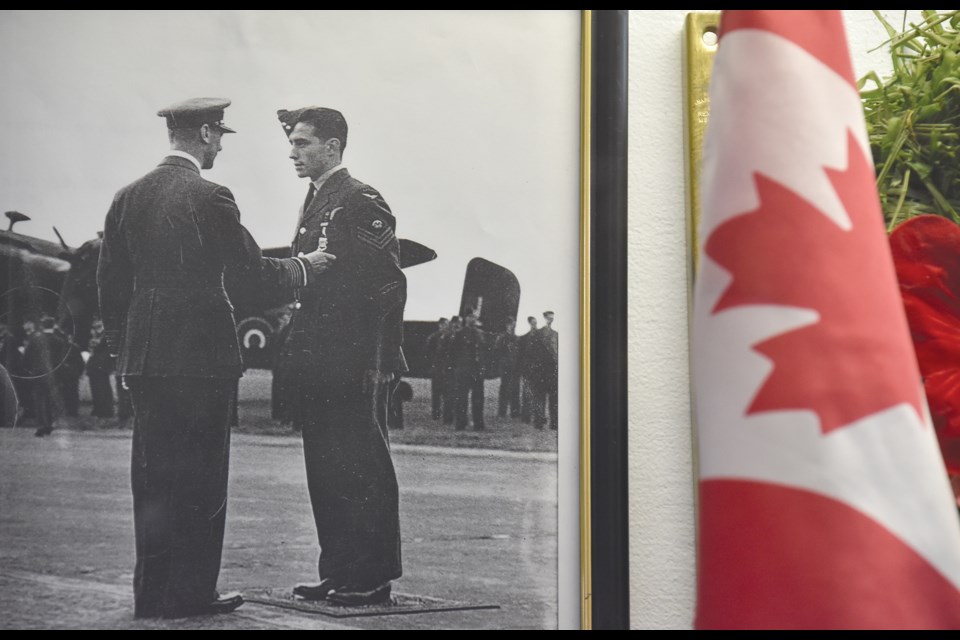In a kitchen in a village in central Alberta, Marcel Croteau heard the announcement over the radio. He jumped so high his fists hit the ceiling.
He remembers the day well. “The war ends but you carry it with you the rest of your life,” Croteau, 97, told Coast Reporter from his home in Sechelt.
That day – Victory over Japan Day – was remembered at a small ceremony at the Sechelt Legion last Saturday.
COVID-19 public health restrictions kept the event small, with approximately 20 people dropping in to pay their respects over the course of a few hours. Croteau was the sole Second World War veteran in attendance.
Aug. 15 marked the 75th anniversary of the surrender of Japan, effectively ending the war.
There are three Second World War veterans left in the Sechelt area, according to Sechelt Legion president Bill McLean. A rough estimate puts the number remaining on the Sunshine Coast at 20. “They are getting fewer and fewer,” he said.
That includes Royal Canadian Air Force Pilot Officer Croteau, who fought in 39 missions as a tail gunner on Halifax bombers from two days before Christmas 1943 to Sept. 13, 1944.
Croteau won seven battles, including one over Karlsruhe, Germany at approximately midnight on March 28, 1944.
He blew up a German twin-engine Junkers Ju 88, known for their speed and agility.
Croteau managed the feat in three and a half seconds, measuring the length of the battle by his artillery. “My four machine guns fired 73 rounds a second and I used 250 bullets,” he said.
The feat earned him a Distinguished Flying Medal, which was bequeathed by King George VI on Aug. 12, 1944 in northern Yorkshire. Princess Elizabeth was there.
A photo of the ceremony is now displayed in the Legion’s C.S.M. James Hamilton memorabilia cabinet.
Since the war’s end and despite the losses, Croteau said he doesn’t “hold any animosity against the German people.”
And while it was nice to get the recognition last Saturday, said Croteau, he is always wary of celebrations of war. “I don’t really like to brag about it. [It was] human being against human being.”
More than one million Canadians served in the war and 44,090 died. Of the 250,000 who served in the Royal Canadian Air Force, 17,397 died.
Legion ‘treasure’ uncovered
Last Saturday the Legion also revealed a drawing from May 1945 by former Legion member Charles Pratt, who served in the Pacific during the Second World War.
McLean said he recognized the significance of the picture as soon as he uncovered it in the Legion’s attic two months ago. The image was likely drawn in the field, said McLean, and still bears the creases where it was folded. “It’s just such a treasure,” he said. “Everybody was amazed that it even existed.”
The image also speaks to the tensions of war. Inscribed on the top is “V-E” Day. Below Pratt portrays an Allied soldier firing at two Japanese soldiers, which McLean said is meant to depict “the irony of celebrating Victory in Europe Day as the soldiers, sailors and aviators in the Pacific were still at war, and as it turns out, would be for just over three more months.”
While the artwork was uncovered in June, the Legion kept it private intentionally. “It was only fitting that Pratt’s work saw the light of day and was able to be shared on the 75th Anniversary of Victory over Japan Day and the end of World War Two,” said McLean.
Croteau was one of the first to see the image, but when asked by Coast Reporter he reserved comment on what it depicted. “The pictures that I have engraved in my soul is the war. My action, my participation in the war, whenever it was, wherever it was.”



